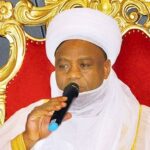Two more pupils were missing, after they were washed away in the powerful currents which swelled up to above knee level, submerging most parts of the area.
The heavy down pour lasted for only about an hour, but the flood it caused devastated Tudun Kauri and various other sections of Lafia-East.
Not far from the same area, about a year earlier from the school flood incident, a Peugeot Station Wagon belonging to the People’s Democratic Party (PDP) in Lafia local government was washed off a street while party officials who drove in it were meeting in a house in the Angwan Yazawa area. It was broad daylight – between 1pm and 2pm which the rain lasted, but the occupants only came out of their meeting to discover the vehicle was missing. Upon inquiries, the party men were told the PDP-marked station wagon was lying some distance, in-between trees where a surging flood washed it to.
Lafia, a flood prone area had similar stories all round the metropolis. The two incidents are just a part of what used to be the narrative of Lafia, anytime the rains drop, and it did not spare anybody, irrespective of status since the state capital is only a big slum – suffering from years of neglect.
For 16 years after creation, the state was still wearing the old infrastructure including roads and drainages it inherited from the mother state, the old Plateau State. The founding fathers of the young state, who led the agitation to go a separate way from the mother state, cited structural imbalance, saying the Upper Plateau shut the doors of development against Lower Plateau (as Nasarawa was called then), denying the area infrastructural, economic and political development.
The only available infrastructure, especially in Lafia, was what the pioneer military administrations provided, before they handed over to indigenes at the return of democracy in 1999.
The period between 1999 and 2011 when indigenous leaders assumed office marked the steep decline in actualizing that noble dream of the founding fathers for a state that will provide for its citizens.
But all that has changed now. There is a new narrative to the condition in Lafia, three years of the administration of Governor Umar Tanko Al-Makura, who initiated a project to fight storm waters out of the state capital. Called “Project Shovel”, the civil engineering project has brought Lafia witnessing three straight years of construction which targets urban renewal through the provision of roads and side drainages to address floods and erosion. Lafia is not the only urban centre witnessing this; Akwanga and Keffi have enjoyed these provisions, just as headquarters of all 13 local government areas across the state are equally getting the civil engineering attention.
The change process is what ushered in the new era, where, for the first time, Lafia and other urban centres of the state are wearing their first ever asphalt roads, and standard drainage system to take storm waters out of the metropolis. There are also traffic lights, mounted at four major junctions, to address congestion and chaotic traffic situations through the metropolis, in what is gradually changing the landscape of Lafia from the hitherto big slum, into a decent and liveable metropolis. These days, Project Shovel has seen street lights on much of these roads provided recently.
This project has opened up many locations which were hitherto inaccessible, a development which property owners are taking advantage of, by changing price tags over and over again on their property.
The roads that have come up are: Stanbic-Kurikyo Road with a distance of 4kms, Alkali Street, and 1km Ministry of Information (Ado Muazu)-Kurikyo Road. The scope of work is surface dressing and side drainages.
There is 900m Abdul Shitu/Ministry of Information-Kurikyo Road Junction, with the scope of surface dressing and side drainages; and 530km Abdul Kura Street with the scope of stone base and asphalt layout as well as side drainages.
There is Lafia-East-Government House-NADP Quarters with spur towards Makon Giji Shendam Road Junction at the distance of 4.8kms; and People’s Bank-New Market Road Junction running into 1.2kms. The scope is asphalt laying and side drainages construction.
Agwai Junction-Angwar Nungu Junction at the distance of 1.5kms, with the scope of asphalt laying and side drainages also came up.
Seventeen years after, the state is also having its first two dual carriage ways being provided by the state government. Ther are running from Lubona Junction off Makurdi Road, to Lafia-East Primary School through Lafia Modern Market, in the Lafia East section of the metropolis, and from Post Office Junction along Makurdi Road through the Timber Market, to Railway, in the UAC section of the metropolis, respectively.
 Join Daily Trust WhatsApp Community For Quick Access To News and Happenings Around You.
Join Daily Trust WhatsApp Community For Quick Access To News and Happenings Around You.


